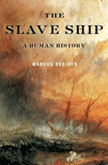The gruesome cargo beneath the “Inexhaustible Fund of Wealth.”

THE SLAVE SHIP:
A Human History
Marcus Rediker Gr’82.
Viking, 2007. $27.95.
By Dennis Drabelle | The slave ship was a microcosm of systematic terror, argues Marcus Rediker in this study of the phenomenon. During the long reign of that terror—from the 15th century to the 19th—more than 10 million human beings were abducted and taken forcibly across the Atlantic Ocean, while another 1.8 million died en route.
The burden of fear weighed most heavily on slaves themselves, of course, but no one on board could escape it. Few sailors freely chose their service on a slave ship. If they weren’t shanghaied or persuaded to sign up while drunk, they took the job because they had debts to pay off and no other options. Once the ship got underway, the crew dreaded what might befall them at their tropical destination, with its battery of unfamiliar diseases. Sailors who survived that leg of the journey had to contend with the “goods” being transported to the New World: a hundred or more traumatized passengers, some of them sick, others so outraged that they might commit civil disobedience or organize a mass uprising. Ordinary seamen might be drafted into service as enforcers, wielding the cat o’ nine tails, or might themselves become victims of brutality administered by their superiors. Even the captain lived in fear of the many things that could go wrong in the floating jailhouse of which he was warden. To allay that fear, he enforced strict discipline, with ruthlessness being virtually part of the job description. Put this all together, and you have a milieu with violence at its “very heart.”
A history professor at the University of Pittsburgh, Rediker concentrates on British vessels making the Middle Passage from West Africa to the West Indies. His sources range from maritime archives to a classic narrative by Olaudah Equiano, a slave who was carried off at age 11, to an influential abolitionist broadside that won converts by providing a bird’s-eye view of what you would see if the upper deck of a slave ship were peeled away: dozens upon dozens of people crammed into tight rows like so many chained-together logs.
In addition to the cat o’ nine tails, slave-ship accoutrements included netting, to keep slaves from jumping overboard; the speculum oris, a tool for force-feeding slaves on hunger strikes; and the barricado, a built-in fence separating the enslaved from the free. Barricado or no, slaves occasionally managed to take over a ship (Herman Melville used one such incident as the basis for his story “Benito Cereno”), and other rebels scored a more perverse success: fighting the crew to the death, thus depriving the captain and his backers of their mission’s raison d’etre.
As the author knows full well, this is a grim subject indeed, but The Slave Ship has its moments of humanity and triumph. There are bracing stories of slavery proponents who saw the light, the most famous being former ship captain John Newton, best known as author of the hymn “Amazing Grace.” Most commanders of slave ships either clammed up or lied about what they had wrought, but the contrite Newton “may have written more … about what transpired on the decks of a slave ship than has any other captain in almost four centuries of the trade,” notes Rediker. He ends the book on a gently upbeat note, with an anecdote about the kindliness shown to broken-down English sailors—most of them exhibiting the effects of tropical diseases—who hung around West Indies wharves. Displaying a near-saintly humanity, some “negroe women” took in these former cogs in the slavery machine and nursed them back to health.
The research that went into The Slave Ship is impressive, and Rediker gives a vivid—and sometimes harrowing—sense of the misery that seems to have dominated every voyage. For this reader, however, the book’s early sections could have done with more and better signposts. For example, a series of place-portraits in Chapter 3 comes into focus only after they’re all down on the page and the author writes, “As the summaries of the six main slaving regions suggest …” It would have been helpful to have those words as an entrée to the material, rather than an exit.
The question that inevitably haunts any book on the slave trade is how it could have been countenanced for so long. Self-delusion played a part. A British pro-slavery lobbyist named Malachy Postlethwayt wrote a pamphlet in which he claimed that Africans were better off “living in a Civilized Christian Country” than in their supposedly benighted homeland. But appeals to the national interest may have been more effective. The slave trade, Postlethwayt went on, represented “an inexhaustible Fund of Wealth and Naval Power to this Nation”—and for a while that way of framing the argument ended the discussion.
It also took ignorance to keep the ships running. As mentioned, slaver captains kept information about their voyages bottled up, and seaman whistle-blowers were not always the most articulate witnesses. The conspiracy to shield the public from the gruesome truth held up until 1788, when abolitionists published that broadside depicting conditions on the slave ship Brooks, with its X-ray view of slaves jammed into place. “Here was the new, modern economic system in all its horrifying nakedness,” Rediker writes, “capitalism without a loincloth …” Once the image was out and circulating, it took Parliament less than 20 years to decide that Britain could do without its “inexhaustible Fund of Wealth and Naval Power.” Yet how crude and simplistic the Brooks diagram looks to the modern eye. If photography had only come along a few generations earlier, you find yourself wondering, would the slave trade have lasted as long as it did?
Dennis Drabelle G’66 L’69, a frequent contributor to the Gazette, is a contributing editor of The Washington Post Book World.




